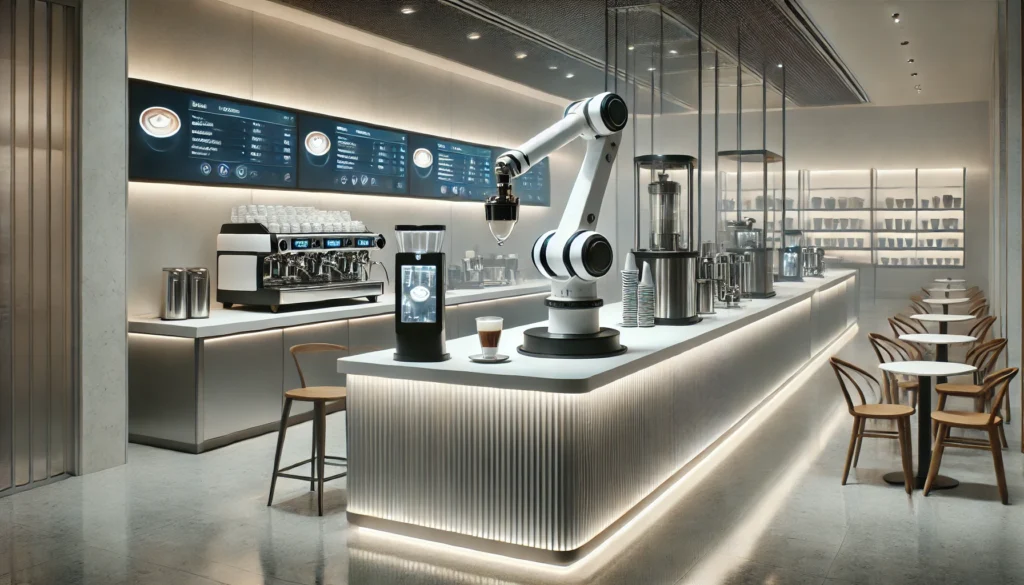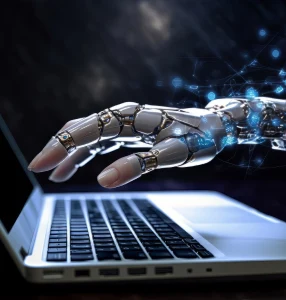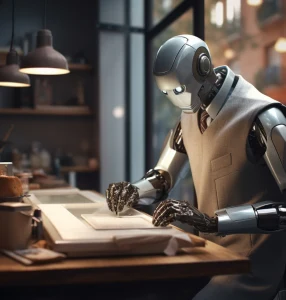Introduction
In the heart of the 21st century, the quintessential cafe experience—once characterized by the rhythmic sounds of espresso machines, the aroma of freshly ground coffee, and the personal touch of skilled baristas— is undergoing a remarkable transformation. As we navigate through an era where technology intertwines with every aspect of our lives, the emergence of robotic cafes marks a significant milestone in the evolution of the hospitality industry. This innovative concept, blending the ancient art of coffee-making with the cutting-edge precision of robotics, offers a glimpse into a future where automation and artificial intelligence (AI) become integral to our daily routines.
Robotic cafes, with their promise of efficiency, consistency, and novelty, are not just a testament to human ingenuity but also a reflection of the changing dynamics in consumer preferences and business operations. The drive towards automation, fueled by advancements in technology and shifting economic landscapes, has found its way into the cozy corners of our local coffee shops, redefining the very essence of cafe culture. As these automated baristas begin to populate cities around the globe, they challenge our traditional notions of service and craftsmanship, inviting us to reconsider what we value in the coffee-drinking experience.
This blog post embarks on a journey to explore the rise of robotic cafes— from their conceptual inception to their current reality and beyond. We delve into the mechanics of how these futuristic establishments operate, the benefits they offer over traditional cafes, the challenges they face, and the potential they hold to reshape the future of the cafe industry. Join us as we uncover the layers of this technological marvel, examining its impact on society, culture, and the environment, and pondering the role of innovation in redefining the boundaries of human experience.
The Rise of Robotic Cafes
The advent of robotic cafes is a narrative of innovation meeting necessity, a story that begins with the ever-increasing quest for efficiency and precision in the service industry. As technology advanced, the hospitality sector, renowned for its emphasis on personal touch and craftsmanship, began to envision a future where these human qualities could be complemented—rather than replaced—by automation. This vision laid the groundwork for the emergence of robotic cafes, establishments that epitomize the marriage between the age-old tradition of coffee brewing and the avant-garde of robotic automation.
A Glimpse into History
The concept of a robotic cafe wasn’t born overnight. It was the culmination of decades of technological advancements in robotics, artificial intelligence (AI), and machine learning. The early 21st century saw the first prototypes—machines capable of performing simple tasks such as grinding beans and brewing coffee. However, it wasn’t until the mid-2010s that the first fully automated, robot-barista-operated cafes began to appear in tech-savvy cities around the world. These pioneering establishments offered not just a cup of coffee but a window into the potential of automation in enhancing service efficiency and consistency.
Technological Catalysts
Key to the rise of robotic cafes has been the development of sophisticated AI and robotics capable of mimicking the intricate motions and decisions of a human barista. Advances in sensor technology, machine learning algorithms, and mechanical engineering have enabled robots to grind coffee, steam milk, and create various coffee beverages with a precision that rivals, and sometimes surpasses, that of humans. This technological leap forward has been accompanied by a growing consumer fascination with automation and AI, making robotic cafes as much a cultural phenomenon as a technological one.
Driving Forces
Several factors have fueled the adoption of robotic technology in the cafe industry. The quest for consistency in quality stands paramount—robotic baristas can replicate the exact parameters for brewing the perfect cup of coffee every single time. Efficiency and speed are also significant advantages, with robots capable of serving customers with minimal wait times, thereby enhancing the overall customer experience. Furthermore, the novelty of robotic cafes attracts customers eager for a taste of the future, transforming the coffee-drinking experience into an engaging spectacle.
Economic and Social Implications
The economic implications of robotic cafes extend beyond the walls of the establishments themselves. By reducing the need for human labor, these cafes can potentially lower operational costs and offer a scalable model for expansion. However, this shift also raises questions about the future of employment in the hospitality sector and the balance between technological advancement and human touch in service industries.
As robotic cafes continue to proliferate, they serve as a testament to human ingenuity and a reminder of the continuous dance between tradition and innovation. They are not merely establishments serving coffee but symbols of a future where technology and human craftsmanship coexist in harmony, each enhancing the value of the other. The rise of robotic cafes is just the beginning of a broader exploration into the potential of automation to transform our social and economic landscapes, challenging us to reimagine the boundaries of what is possible.
How Robotic Cafes Work
At the intersection of technology and tradition lies the robotic cafe, a marvel of modern engineering that has revolutionized the simple act of getting a cup of coffee. These futuristic establishments operate through a symphony of advanced robotics, artificial intelligence (AI), and meticulous programming, offering a seamless and interactive customer experience. Here’s a closer look at the inner workings of robotic cafes, from order placement to the final sip.
The Heart of Automation: The Robotic Cafes
Central to the robotic cafe is the robotic barista, an assembly of mechanical arms, sensors, and tools designed to replicate the movements and tasks of a human barista. Equipped with precision-engineered joints and grippers, these robots can handle everything from selecting the right amount of coffee beans to precisely pouring hot water over them, steaming milk to the perfect temperature, and even creating latte art. Advanced vision systems allow the robot to accurately position cups, identify ingredients, and monitor the quality of each drink.
Intelligent Systems: AI and Machine Learning
Behind the mechanical prowess of the robotic barista is a brain powered by AI and machine learning algorithms. This digital brain controls the robot’s movements, ensuring each task is performed with exact precision. Machine learning allows the system to improve over time, learning from every cup made to refine recipes, adjust techniques, and ensure consistency. AI also enables the robotic cafe to personalize orders, remember customer preferences, and even predict popular menu items based on trends and time of day.
Customer Interaction: The Ordering Process
The customer experience at a robotic cafe is designed to be as engaging and efficient as possible. Orders are typically placed using touchscreen kiosks in the cafe or through a mobile app, allowing customers to customize their drinks down to the smallest detail. Once an order is placed, the system assigns it to the robotic barista, which then begins the drink-making process. Digital displays and transparent enclosures allow customers to watch as their coffee is prepared, turning the wait into an entertaining show.
From Beans to Brew: The Coffee Making Process
The process of making coffee in a robotic cafe is a spectacle of precision and efficiency. Once an order is received, the robot selects the appropriate beans, which are then ground to the exact coarseness required for the selected beverage. Water heated to the precise temperature is poured over the ground coffee, ensuring optimal flavor extraction. For milk-based drinks, milk is frothed to the perfect consistency and temperature. The final step is assembling the drink, which can include adding syrups, toppings, or even creating intricate latte art, all executed with robotic precision.
Safety and Hygiene
Robotic cafes excel in areas of safety and hygiene, with systems designed to minimize human error and contamination. The automation of the coffee-making process reduces the number of touchpoints, thereby lowering the risk of hygiene breaches. Regular maintenance and cleaning protocols are programmed into the robot’s operations, ensuring a clean and safe environment for both the machinery and the customers.
Seamless Service
The culmination of this technological symphony is a cup of coffee delivered with unmatched consistency and efficiency. Robotic cafes represent not just a novelty but a new standard in the delivery of food and beverage services. As these cafes continue to evolve, they will undoubtedly refine and redefine the intersection of technology and hospitality, offering glimpses into a future where automation enhances every aspect of the customer experience.
Advantages of Robotic Cafes
In the bustling world of coffee lovers and technology enthusiasts, robotic cafes have brewed up a storm of interest, offering a unique blend of efficiency and novelty. These high-tech havens serve up more than just your morning cup of joe; they present a myriad of benefits that are reshaping the cafe landscape.
- Unmatched Consistency: Imagine sipping your favorite coffee, with its flavor, temperature, and strength hitting the sweet spot every single time. Robotic cafes excel in delivering this dream, thanks to precise control over every variable in the coffee-making process. From the grind size of beans to the brewing temperature, robots ensure a level of consistency baristas strive for.
- Efficiency and Speed: In a rush? Robotic cafes have got you covered. With streamlined operations and multitasking capabilities, these cafes minimize the wait time, serving customers swiftly without sacrificing quality. This efficiency is a boon during peak hours, ensuring that coffee aficionados get their caffeine fix without the dreaded wait.
- Innovative Customer Experience: The experience of watching a robotic arm craft your coffee adds a layer of fascination to your cafe visit. It’s not just about grabbing a quick drink; it’s about witnessing the future of hospitality in action. This innovative encounter not only attracts tech-savvy individuals but also offers a unique selling point that sets robotic cafes apart.
- Reduced Human Error: While the human touch is irreplaceable in many aspects of hospitality, it does come with the susceptibility to mistakes. Robotic cafes streamline operations by significantly reducing errors in order preparation, ensuring that each beverage is made to specification. This reliability enhances customer satisfaction and brand trust.
- Operational Efficiency:
- Cost Savings: By automating routine tasks, robotic cafes can operate with fewer staff, leading to potential savings on labor costs. These savings can be redirected towards improving the customer experience or expanding the business.
- 24/7 Potential: Robots don’t need breaks or sleep, allowing for the possibility of round-the-clock operations. This availability can cater to customers at times when traditional cafes are closed, capturing a market segment that goes untapped by human-run establishments.
- Adaptability: With advancements in AI and machine learning, robotic cafes can quickly adapt to new trends, preferences, and seasonal changes. This adaptability means menus can be updated with minimal downtime, keeping the offerings fresh and exciting.
- Hygiene and Safety: In a post-pandemic world, the emphasis on hygiene has never been more critical. Robotic cafes minimize human contact with food and beverages, offering a safer and more hygienic environment. This aspect is particularly appealing to health-conscious customers.
Robotic cafes represent a confluence of tradition and innovation, where the timeless ritual of coffee drinking meets the cutting edge of technology. As these cafes continue to proliferate, they offer a tantalizing preview of the future—a world where technology enhances our daily rituals, making them more enjoyable, efficient, and consistent.
Challenges and Considerations
While robotic cafes dazzle with their efficiency and innovation, navigating the landscape of automation in the hospitality industry comes with its unique set of challenges and considerations. These hurdles highlight the delicate balance between embracing technology and preserving the essence of the cafe experience that patrons have cherished for centuries.
- High Initial Investment: The upfront cost of integrating advanced robotics and AI systems into cafes is substantial. Beyond purchasing the machinery, significant investments in software development, maintenance, and periodic upgrades are required to keep the cafe at the forefront of technological advancements. For small business owners, these costs can be prohibitive, making it a challenge to enter the robotic cafe market.
- Technical Glitches and Maintenance: Dependence on sophisticated technology introduces the risk of operational hiccups. From malfunctioning robotic arms to software errors, technical issues can disrupt service, affecting customer satisfaction. Regular maintenance and technical support are paramount, yet they add to the operational costs and complexity of running a robotic cafe.
- Customer Perception and Experience: For many, the allure of cafes extends beyond coffee to the warmth of human interaction and the ambiance of the setting. Skeptics of robotic cafes argue that automation may strip away this essence, turning coffee shops into impersonal spaces. Overcoming this perception and creating an inviting atmosphere that complements the technological marvel is a significant challenge.
- Adapting to Complex Customer Requests: While robotic systems excel in consistency and efficiency, they may struggle with the nuances of highly personalized orders. The current technology may not fully capture the bespoke nature of human service, where a barista can intuitively adjust a drink based on a customer’s vague or complex request. Bridging this gap remains a considerable challenge.
- Employment and Ethical Considerations: The automation wave brings with it concerns about job displacement within the hospitality sector. As robots take on roles traditionally filled by humans, the industry must grapple with the ethical implications of reducing human labor. Finding a balance between leveraging technology and preserving employment opportunities is a critical consideration for the future of robotic cafes.
- Market Saturation and Differentiation: As more entrepreneurs and corporations jump on the robotic cafe bandwagon, standing out in a crowded market becomes increasingly challenging. Differentiating a robotic cafe in a sea of similar offerings requires innovation not just in technology but also in marketing, branding, and customer engagement strategies.
- Regulatory Hurdles: Navigating the regulatory landscape can be tricky, especially in regions with stringent health, safety, and employment laws. Ensuring compliance while pushing the boundaries of what a cafe can be involves a delicate dance with local authorities, which can be both time-consuming and complex.
Despite these challenges, the journey of robotic cafes is a testament to the human spirit’s relentless pursuit of innovation. As the industry continues to evolve, so too will the solutions to these hurdles, paving the way for a future where robotic cafes are not just a novelty but a staple of urban life. The key lies in harmonizing technology with the human elements of hospitality to create spaces that are not only efficient but also warm and welcoming.
Revolutionizing Coffee Culture with Robotic Cafes in Canada
The introduction of robotic cafes in Canada marks a significant milestone in the intersection of technology and hospitality, offering a glimpse into the future of the coffee industry. This case study explores pioneering establishments in Toronto and Vancouver, showcasing how they navigate the challenges of integrating robotics into their operations and the impact they’ve had on the local cafe scene.
Quantum Coffee – Toronto
Quantum Coffee, nestled in the heart of Toronto’s bustling city center, has embraced automation with its innovative coffee-making robot. This establishment has become a beacon of modernity, drawing in both coffee aficionados and tech enthusiasts eager to witness the fusion of high-quality coffee and cutting-edge technology.
- Innovation and Experience: Quantum Coffee’s robotic system is not just about efficiency; it’s a part of the customer experience. Patrons can watch as their coffee is meticulously prepared by a robotic arm, transforming the act of grabbing a morning espresso into an engaging spectacle.
- Overcoming Challenges: One of the initial hurdles was integrating the robotic system in a way that complemented the cafe’s warm and inviting atmosphere. By incorporating interactive elements and ensuring the robot was visible to customers, Quantum Coffee managed to create a balance between technology and comfort.
- Impact: The introduction of robotics has allowed Quantum Coffee to consistently serve high-quality coffee with reduced wait times, significantly enhancing customer satisfaction. Moreover, the novelty of the robotic barista has attracted a steady stream of curious visitors, boosting foot traffic and making the cafe a landmark for innovation in Toronto.
RC Coffee – Toronto
RC Coffee has emerged as a standout player in the realm of automated coffee solutions, with kiosks spread across Canada. This brand has taken the concept of the robotic cafe to new heights, offering a fully automated coffee kiosk experience that marries convenience with quality. RC Coffee represents a significant leap forward in making robotic cafes accessible to a wider audience, demonstrating the scalability of this innovative concept.
- Innovative Kiosk Model: RC Coffee’s kiosks are compact, automated coffee stations where customers can order their favorite beverages via a touchscreen interface or a mobile app. These kiosks use robotic arms and advanced brewing technology to prepare a wide range of coffee drinks, from classic espressos to more elaborate lattes, all with the precision and efficiency that robotic technology offers.
- Strategic Expansion: One of the keys to RC Coffee’s success has been its strategic placement of kiosks in high-traffic areas, including office buildings, airports, and shopping centers. This approach not only brings high-quality coffee closer to consumers but also demonstrates the versatility of robotic cafes in catering to the fast-paced lifestyle of modern society.
- Overcoming Challenges: The rollout of RC Coffee kiosks has not been without its challenges. Ensuring consistency across multiple locations, managing maintenance and technical support remotely, and tailoring the coffee menu to diverse customer preferences have all been part of the learning curve. However, RC Coffee’s commitment to continuous improvement and customer satisfaction has helped them navigate these hurdles effectively.
- Community Engagement and Sustainability: Despite being a fully automated brand, RC Coffee has made strides in engaging with the communities it serves. From sourcing ethically produced coffee beans to implementing eco-friendly practices in their operations, the brand has shown that automation does not have to come at the expense of social responsibility or environmental sustainability.
- Impact and Reception: RC Coffee’s kiosks have been well received by the Canadian public, offering a novel and convenient way to enjoy high-quality coffee. The success of RC Coffee highlights the potential for robotic cafes to become an integral part of the urban landscape, providing a glimpse into a future where technology and convenience seamlessly blend into our daily routines.
RC Coffee’s innovative approach to automated coffee service showcases the versatility and potential of robotic cafes to adapt to various environments and meet the evolving needs of consumers. As robotic technology continues to advance, the story of RC Coffee and its impact on the Canadian coffee scene will undoubtedly inspire further innovation and expansion in the field of automated hospitality services.
Conclusion
As we reflect on the journey of robotic cafes, from the pioneering establishments in Toronto and Vancouver to the innovative RC Coffee kiosks dotting the Canadian landscape, it’s clear that we are on the cusp of a significant shift in the hospitality industry. These case studies illuminate a path forward, marked by innovation, efficiency, and an evolving relationship between technology and human interaction. The integration of robotics into cafes is not just about automating the process of coffee making; it’s about reimagining the possibilities of service, convenience, and experience in the digital age.
The rise of robotic cafes brings with it a plethora of advantages, from the consistent quality of beverages to the operational efficiencies that can transform business models. Yet, as we’ve seen, this new era also presents its challenges—technical hurdles, the need for substantial initial investment, and the imperative to maintain the human element that has long defined the cafe experience. The success stories of Quantum Coffee, The Automated Cafe, and RC Coffee demonstrate not only the potential to overcome these challenges but also the opportunities to redefine what a cafe can be in the 21st century.
As we move forward, the trajectory of robotic cafes will undoubtedly be shaped by advancements in technology, shifts in consumer behavior, and the ongoing dialogue between tradition and innovation. The key to sustainable growth in this exciting new frontier will be in balancing efficiency and automation with creativity, community, and the personal touch that has always been at the heart of the cafe culture.
The journey of robotic cafes is just beginning, and it promises to be as dynamic and diverse as the communities they serve. By embracing the possibilities that technology offers, we can look forward to a future where robotic cafes are not just a novelty but a staple of our urban fabric, offering new ways to connect, recharge, and enjoy the simple pleasure of a great cup of coffee. In this future, the essence of the cafe remains unchanged—a place of community, comfort, and connection—yet enriched by the innovations that define our age.
Read more about Server Robots in Restaurant Industry.






